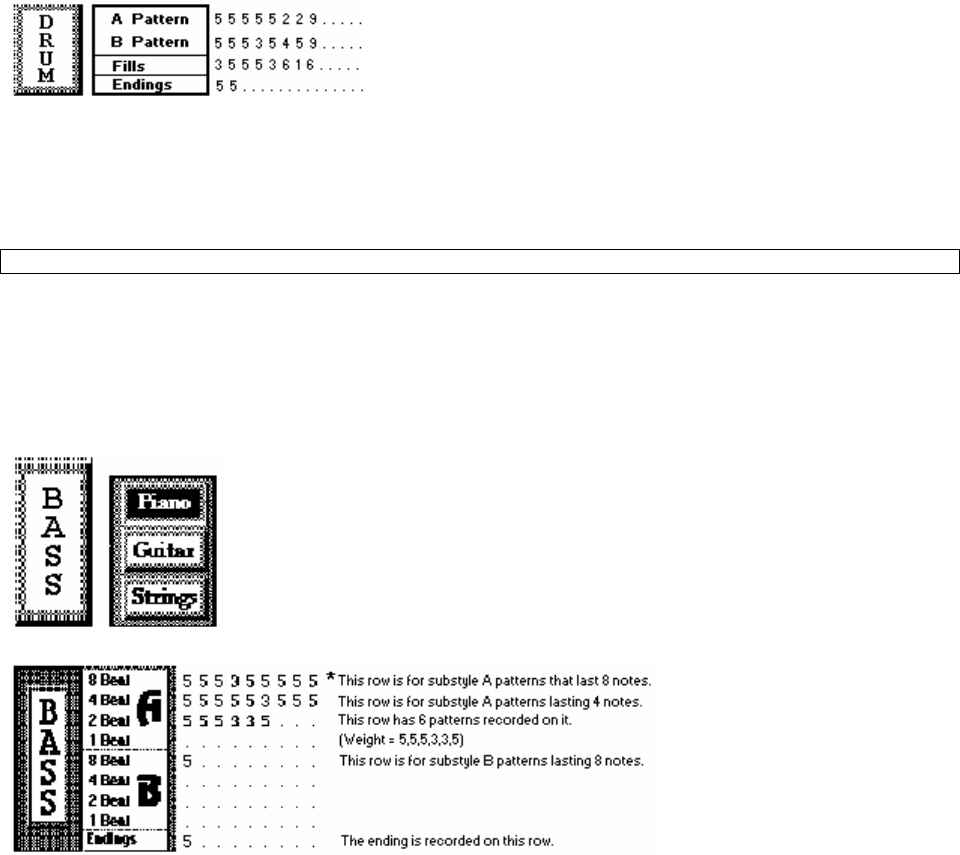User Guide
Table Of Contents
- PG Music Inc. License Agreement
- Table of Contents
- Chapter 1: Welcome to Band-in-a-Box!
- Chapter 2: QuickStart Tutorial
- Chapter 3: Band-in-a-Box 2010.5 for Macintosh
- Welcome to Band-in-a-Box 2010.5
- New Features in Band-in-a-Box 2010
- More New RealTracks
- QuickStart Tutorial
- Quick Song Settings
- Save Default Mix
- Improved Audio Rendering
- DAW Plug-in Mode
- Freeze Tracks
- RealTracks Enhancements
- New Favorite Songs/Styles Dialog
- Rendering Tracks
- StylePicker Enhancements
- New in the StyleMaker
- Chapter 4: The Main Screen
- Chapter 5: Guided Tour of Band-in-a-Box
- Chapter 6: Band-in-a-Box PowerGuide
- RealTracks
- RealDrums
- Song Settings
- The Chordsheet
- Chord Preview/Builder
- MIDI file “Chord Wizard”
- Applying Styles
- The StylePicker
- Playing, Pausing, and Stopping Songs
- Changing Volume, Panning, Reverb, Chorus, Bank
- Freeze Tracks
- Saving Songs
- Preferences – User Settings
-
- Show Chords with push/rest chars
- Metronome During Recording
- Harmony Volume Adjust
- OK to Load Style with songs
- Write Guitar part on 6 channels
- Turn External Keyboard’s Local On at end of session
- OK to beep with messages
- OK to prompt to reduce/expand
- For Roman Numerals in minor keys, use relative major
- Save Button on main screen works as Save As
- Name MIDI files with .MID extension
- Allow larger fonts on Chordsheet
- Color for Chordsheet Area
-
- Other Editing Features
- MIDI Setup
- The JukeBox
- Chapter 7: Notation and Printing
- Chapter 8: Automatic Music Features
- Chapter 9: Recording Tracks
- Chapter 10: Audio Features
- Chapter 11: Wizards, Tutors, and Fun
- Chapter 12: User Programmable Functions
- Chapter 13: CoreMIDI and Apple DLS Synth
- Chapter 14: Reference
- PG Music Inc.
- Index
- Registration Form

Chapter 12: User Programmable Functions
222
A patterns This row is for 1 bar drum patterns for the “a” substyle.
B patterns This row is for 1 bar drum patterns for the “b” substyle.
Fills This row is for 1 bar drum patterns for the “a” substyle.
Endings This row is for endings. Endings are 2 bars (2 patterns of 1 bar each). If you‘ve made a style and
haven’t included an ending, a 2-bar “auto-ending” can be generated automatically, based on the style.
Tip: If you are making a simple style, you only need to use the top row (“a” patterns).
Bass / Piano / Guitar / Strings patterns:
- Are played in real time from a MIDI keyboard, MIDI guitar, etc. by clicking on [Rec] or typing “r” with the
cursor placed on the first dot of the A or B section of the desired instrument starting with 8 Beat.
- Are played in based on a C7 chord (C E G Bb) though all 12 notes may be used.
The patterns for Bass/Piano/Guitar/Strings are classified by the length of the pattern, i.e., the number of notes that
the chord lasts without a change of chord.
Click on the Piano/Guitar/Strings buttons to toggle between each instrument’s A/B
recording sections. You get to the instrument screen by mouse clicking on the
instrument name button.
For example, click on the Bass button and you will see similar to the following:
The important rows are indicated with an asterisk *, meaning that if you are making a simple style you'll only have
to use these rows. The “a” and “b” refer to the “a” and “b” substyles found in Band-in-a-Box. The numbers 1, 2, 4,
8 refer to the length of the recorded patterns in terms of number of beats. For example, a 2 bar pattern would be = 8
beats.
Explanation of the numbers
on the StyleMaker screen.
The StyleMaker screen is full of patterns, mostly empty indicated by a period (.). When a pattern has been recorded, there is a
number in place of the period for example (5). These numbers indicate whether a pattern has been recorded at the location.
A period indicates no pattern and a number from 1 - 9 indicates that a pattern has been recorded with the actual value
corresponding to the desired weight the pattern is to be given relative to other similar patterns. Patterns that you don't want to
hear very often in the style are given low weights. Usually you will use weights in the range of 0 - 8 where
0 = no pattern recorded
1 -
– 8 = pattern recorded
9 = special weight that is really given a much higher weight internally by the program. A pattern with a weight of 9 will always
be played (if not masked out by other options).
“a” and “b” refer to the 2 substyles available in the Band-in-a-Box program.
Explanation of the pattern lengths 8, 4, 2, and 1 beat.
You may ask, “Why would I need to have different pattern lengths in a style?” Whenever Band-in-a-Box
encounters a chord change in a song it will begin to playback a new pattern, starting at the beginning of the pattern.










